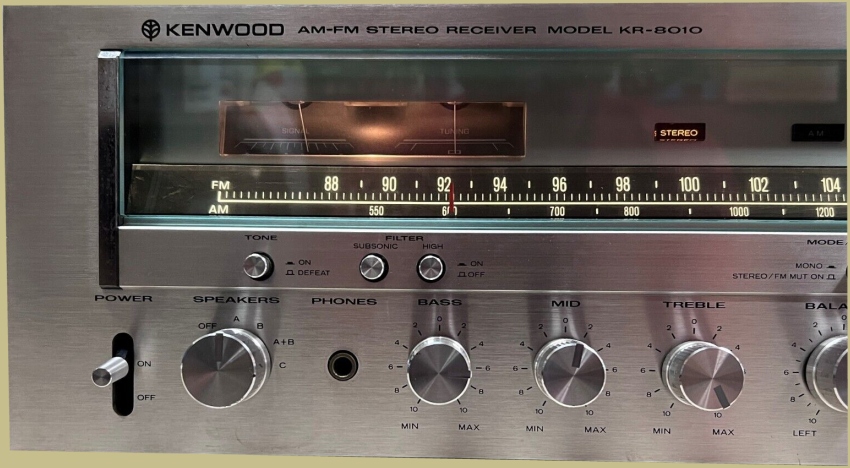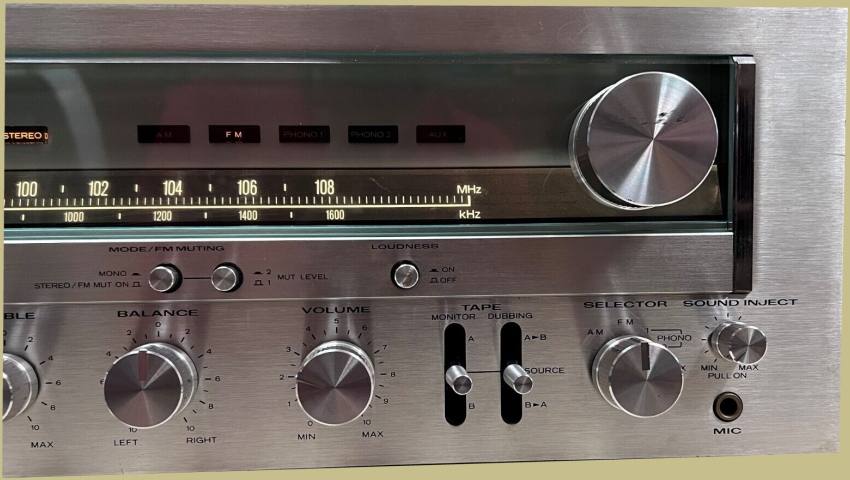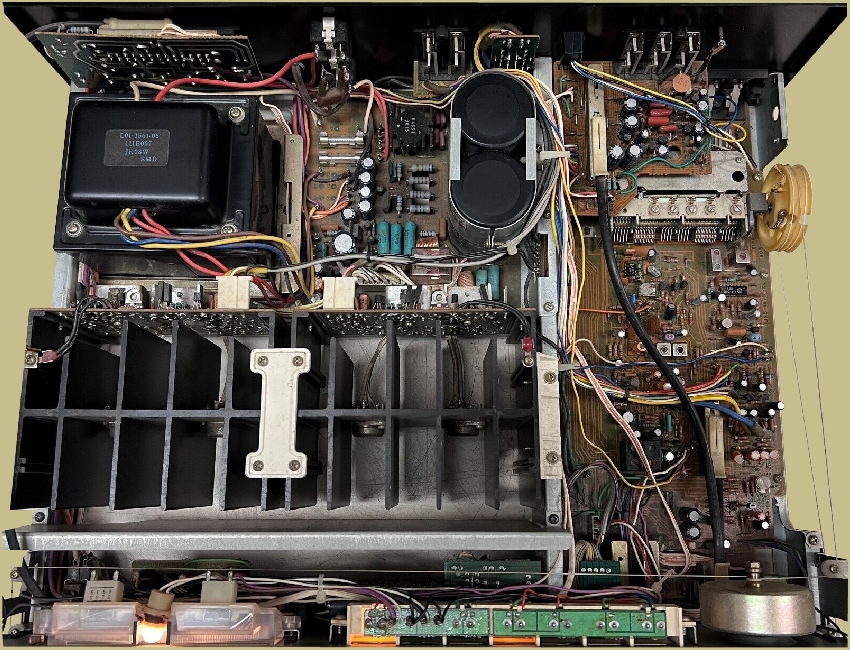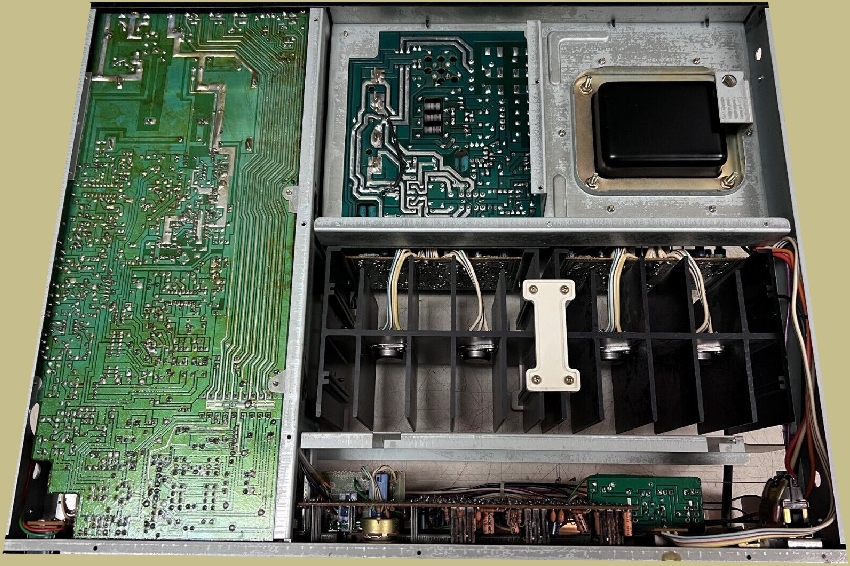
This classic is the Kenwood KR-8010. It was introduced in 1978 and was on the market until about 1981. With 125 watts per channel and 0.03% total harmonic distortion it was near top of the line in Kenwood’s lineup – one step down from the KR-9600. It wasn’t cheap at a retail price of $675 but overall, it is a great looking receiver and excellent performer.

The KR-8010 is a beautiful receiver with a brushed aluminum front panel, diamond-machined knobs, analog meters, and an elegant slide-rule dial. The beveled glass is a nice touch as well. Buyer’s had the option of purchasing the CB-14K walnut veneer cabinet, B-14 walnut veneer side panels, or the D-10 carrying handles.

Controls
The KR-8010 provides sophisticated controls and features. For example, you can copy tapes while listening to another audio source. There are also two levels of FM muting. Other features include: microphone input with fade control, bass, treble and midrange tone controls, tone defeat switch, loudness control, subsonic and high filters, sound injection, and more.
FM Tuner
The FM tuner on the KR-8010 is excellent. It has a highly sensitive FM front end with Dual Gate MOS FET and 4 gang variable capacitor. Of course Kenwood was known for their exceptional tuners due to their experience developing ham radio products.
The FM muting has two different level positions and performs Stereo to Mono switching via an automatic switching circuit.

Sound Injection
The Sound Injection system allows you to mix and record audio from the source selected with the Selector switch along with microphone input. To use Sound Injection, turn the Sound Injection switch to the ON position. The mixing level between the selected source and microphone can be adjusted with the mix level control. For regular listening without mixing, the Sound Injection switch should be in the Off position. There is a microphone jack for mono microphone input only. To turn on Sound Injection, pull the Sound Injection knob outwards to the On position.
Features
Here are the main features of the Kenwood KR-8010:
- 125 watts per channel, Min. RMS both channels driven at 8 ohms, 20Hz-20KkHz, with no more than 0.03% Total Harmonic Distortion.
- Direct-mounted power transistors permit greater heat sink efficiency for cool operation.
- Exceptionally low-noise phono equalizer (90dB) with high overload level.
- 4-pole dual-gate MOS FETs in RF stage and 6-element ceramic filters in IF stage for excellent sensitivity and selectivity (85d8).
- New PLL IC in FM Multiplex with Pilot Canceller Circuit.
- FM Dolby deemphasis switch-and 2-level FM Muting switch.
- Microphone input for overdub on tape and Public Address.
- 2 tape deck capability with bi-directional dubbing and tape-through circuit.
- Triple tone controls with defeat switch.
- Optional CB-14K walnut veneer cabinet, B-14 walnut veneer side panels, or D-10 carrying handles available.

Specifications
- Tuning range: FM, MW
- 125 watts per channel
- Frequency response: 5Hz to 100kHz
- Total harmonic distortion: 0.03%
- Damping factor: 35
- Input sensitivity: 2.5mV (MM), 150mV (line)
- Signal to noise ratio: 84dB (MM), 105dB (line)
- Output: 150mV (line), 30mV (DIN)
- Speaker load impedance: 4Ω (minimum)
- Dimensions: 22-3/4″W x 7-1/2″H x 16-3/4″D (534 x 167.5 x 459mm)
- Weight: 40.3 pounds (18.3kg)
The KR-8010 is well built and the layout makes it fairly easy to work on. Parts aren’t abundant but you can find knobs, restoration kits, and the problematic power relay switch on eBay. You can see what’s currently available on ebay HERE.

One common issue with the KR-8010 is the power switch (same issue with the KR-9600 and other models as well). The voltage going through the switch is high and can cause arcing which can burn the contacts so that they don’t function properly or worst case cause the switch to weld in the on or off position permanently. A new switch will solve the problem if a replacement can be found but you’ll still have high voltage going through the replacement switch.
The original switch can sometimes be salvaged by disassembling it and cleaning the contacts or flipping them around so that the clean side is used for the contact. Disassembling the switch is not for the faint of heart though.
There is also something called the triac mod that can be done with the switch which is highlighted in an AudioKarma thread HERE.

Reviews
Here’s what some owners of the Kenwood KR-8010 have said about it:
It has a remarkable sound when paired with good speakers.
My KR-8010 holds its own against my SX-1250 both in power and quality of sound.
The KR-8010 is one nice piece of audio gear!
Huge receiver with a great shiny vintage look and gobs of power to drive any speakers you have!

With the KR-9600 gobbling up most of the attention, the KR-8010 tends to fly under the radar a bit. That’s a good thing if you’re looking for a higher powered Kenwood receiver because it runs about half the price of a KR-9600. Remember it can have issues with the power switch but so can the 9600. The KR-8010 has all the features you’d really need and 125 watts of power so if you don’t want to spend crazy money on a 9600 then the KR-8010 might be the right choice.


Any way you could post factory specs/drawings of Kenwood b-14 side panels?